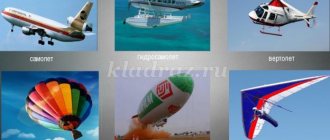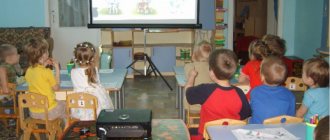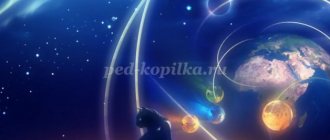Summary of GCD in the preparatory group “Africa” from the series “Traveling the World”
author: Nikolaeva Elena Valerievna
teacher at GBOU School No. 1286
Summary of GCD in the preparatory group “Africa” from the series “Traveling the World”
GBOU School No. 1286 Preschool “Firefly”
Abstract of educational activities on cognitive and research activities in the form of partnership activities between an adult and a child on the topic:
“Travel on the map: part of the world - Africa”
(preparatory group)
Prepared by the teacher:
Nikolaeva Elena Valerievna
Moscow -2021
Target:
Children's acquisition of spatial relationships and patterns.
Tasks:
— Establishment of cause and effect relationships between flora, fauna and their habitat;
— To form children’s ideas about the space of Africa;
— Development of prerequisites for logical thinking;
— Development of the ability to observe and compare;
— Develop partnerships.
Material:
globe, physical map of the hemispheres, black and white map of the hemispheres, physical maps for coloring for children (for each child), cards - illustrations depicting the desert, savannah and tropical forest (A-4), cards depicting the flora, fauna and inhabitants of Africa ( A-5), tag cards with images of African flora and fauna for gluing onto a card (2x2cm)
Preliminary work:
reading the fairy tale by R. Kipling “How did the leopard become spotted?”, K.I. Chukovsky "Doctor Aibolit".
Progress:
V-l is sitting at the table looking at the globe. Children show interest and sit down next to him.
Vl: Guys, remember yesterday we read R. Kipling’s fairy tale “How did the leopard become spotted?
In what part of the world did the events take place?
Children: In Africa.
Q: What was the route of the characters in the fairy tale?
Children: From the dry steppe to the tropical forest.
V-l: Let’s go on a trip to Africa today. First, let's find Africa on the globe. What color is it? Now on the map. Remember, you and I also read “Doctor Aibolit”? How did Doctor Aibolit get to Africa?
Children: On a wolf, on a whale, on an eagle.
V-l: What will you and I go to Africa on?
Children: On the ship.
Vs: Lena, mark our route with a felt-tip pen if we sail on a ship. What else can you use to get to Africa?
Children: By plane, by train and then by ship.
Question: Mark on the map with a felt-tip pen (mark).
V-l: On the way we will make 3 stops: in the desert, in the steppe and in the tropical forest. And our first stop is the desert. (Looks at an illustration of a desert with the children) Who knows the name of one of the deserts in Africa?
Children: Sahara.
V-l: This is one of the largest deserts in the world. What color is the desert? (Yellow) Why? (Because it's covered with sand) Look what we can see in the desert. (look at illustrations of flora and fauna) What do you have? What do you have? What plants grow in the desert? Small herbs, shrubs, trees: cacti, tumbleweeds. What animals live?
Children: camels, snakes, lizards, sand fox, desert hedgehog, cheetah.
V-l: Yes, there are such animals in the desert. Jerboas and gophers also live here, take a look. Let's see what kind of people live in Africa. Bedouins live here - nomads. Desert inhabitants most often live in caves dug in the sand. Why?
Children: Because during hot weather such houses keep cool, and during cold weather they allow you to stay warm.
V-l: Look, what are they doing? (They are engaged in nomadic cattle breeding, hunting, and trading).
Vl: Let's move on. Our second stop is the African steppe. The African steppe has another name - Savannah. Look what's here? (answers) Baobabs are the hallmark of the savannah. Acacias, oil palms, and date palms also grow here. What animals live in Savannah? (Elephants, giraffes, leopards, zebras, rhinoceroses, ostrich) Let's compare the animals of the desert and the steppe. What is the difference? (look at the pictures and compare)
Children: Size and color.
Q: Why are some large and others small? (The savannah has more food, water and space). Let's see what kind of people live in the African steppe: in what houses, what do they do, what clothes do they wear? (They engage mainly in hunting and wear a loincloth). Sedentary tribes build themselves round houses, and nomadic tribes build huts. What are these houses made of? (round ones are made of branches, skins, and huts are made of straw and thin twigs so that they can be easily disassembled).
Next stop is the rainforest or jungle.
What color is Jungle? Why do you think? Who can we meet here? (Gorillas, monkeys, okapi, lemurs, leopard, dwarf buffalo, hornbill, African gray parrot, sunbirds, anaconda, spiders, butterflies, ants, in the rivers - hippos and crocodiles). The inhabitants of tropical forests are much smaller than their relatives living in savannas. For example, duiker antelopes are slightly larger than a hare, the pygmy hippopotamus is half the size of a normal one, and the okapi, a relative of giraffes, is significantly inferior to them in height. What plants grow in the jungle? (vines, ferns, palm trees, bamboo) Let's look at the inhabitants of the jungle, what they wear, what they do. Their life is constantly connected with the forest, because there they live and get food, the pygmies engage in collecting fruits and hunting. Their weapon is a simple bow, which is filled with sharp and poisonous arrows. In the jungles of Africa, houses were built on wooden supports - stilts, which can still be seen today in some tropical settlements. What are piles needed for? (Piles help protect the structure from moisture during the rainy season, and also prevent snakes, rodents and insects from entering the house). Guys, let's compare the plants, animals and inhabitants of the steppe and the tropics. What is the difference? Why? (In the steppe, animals and people are much larger in size, and in the tropics they are smaller, because there is a lot of vegetation in the jungle and it is inconvenient to move around). Guys, do you like Africa? What's so special about her? (eternal summer, heat). What animals and plants are found only in Africa and nowhere else? (giraffe, baobab). How do people live in Africa, what do they do? What fruits will we bring from our journey? (bananas, pineapples, coconuts..) Look at the African animals (giraffe, elephant, zebra, hippopotamus, crocodile, leopard, lion...). Why does a giraffe have a long neck? Why does an elephant need a trunk? Why are the hippopotamus and elephant gray, while the giraffe, leopard, and zebra are yellow and have bright spots or stripes on their skin? (lions and antelopes need to camouflage themselves in the thickets and plains of Africa. Elephants and hippopotamuses have no hair, and they have no rivals - they have no one to fear. How do the coloring and body structure of these animals depend on their habitat? (so that it is not visible on space to camouflage in order to get fruits from tall trees) Let's now take small tag cards, choose the most suitable ones, symbolizing the flora and fauna of Africa and stick them on the map of the hemispheres. (children stick) So our journey is over, it's time for us to return home . Let's see what exotic fruits we brought from our trip. Do they look like our fruits? And what do they taste like? Let's try them. Guys, take home outline maps and color in Africa on the map, think about what colors you will use. And then stick on the appropriate ones. tag cards. And in the evening you can play the game “Journey through Africa.” We will hang a large map of the hemispheres in the group so that you can add new plants and animals to it. Summary of GCD in the preparatory group “Africa” from the series “Traveling the World”
Summary of joint activities with children of the preparatory group Topic: “Travel to Africa”
Completed by: teacher of the first qualification category Magadeeva Dilya Shakiryanovna
GBDOU Children's sai No. 41
Frunzensky district, St. Petersburg, Russia
Target:
To give children a basic understanding of the peculiarities of the geographical location of Africa.
Tasks:
- To consolidate children's knowledge about the animals of hot countries, to activate the vocabulary through the use of new words: continent, dunes, savanna (integration of the educational area “Cognition”).
- Continue to introduce the color designation on the globe (integration of the educational field “Cognition”).
- Continue to develop the need for physical activity through the implementation of various motor tasks (integration of the educational field “Physical Education”).
- Expand ideas about how to properly treat plants and animals (integration of the educational field “Safety”).
- To form a culture of relationships between children and consolidate the skill of team interaction (integration of the educational field “Socialization”).
- To cultivate love and respect for nature (integration of the educational field “Socialization”).
Equipment:
Globe, educational game "Sensino", educational game "Cheese Slice", educational game "Zoo from Tarambuco", educational game "Labyrinth", game simulator "Bumps in the Swamp", game simulator "Turtle", interactive board and console "Mimio" , model of trees, sand, figures of animals from hot countries.
Preliminary work:
Getting to know the continent of Africa through reading fiction.
Drawing of animals living in Africa.
Didactic board games: “Who lives where?”, “Inhabitants of hot countries.”
Compose descriptive stories and memorize poems about animals living in Africa.
Progress of the lesson:
Teacher:
- Guys, look at what an interesting item I brought you. Who knows what this item is called? (globe) What is a globe? (small model of planet Earth) Today, I invite you to go on an exciting journey to the hottest continent of planet Earth. What do you think it's called? (Africa)
Slide 1
Teacher:
— That’s right Africa, let’s see where this continent is located (we look at it on the globe, focusing on the desert, shroud and river). How far Africa is from us, but I have a magic labyrinth that will show us the shortest path, we just need to lay it out correctly.
Educational game “Labyrinth” (child makes way)
Teacher:
- Well, guys, now we know the route, but how do we get there? I offer you an unusual transport - high-speed turtles.
Relay race by teams (game simulator “Turtle”)
Teacher:
- Well done, we did it all! Did you all get there?
Slide 2
Teacher:
Guys, look at the screen! What do you think is shown here? (Planet Earth) That's right, this is our planet! Planet Earth is unique! You and I must protect and defend our Earth. Preserve her beauty.
Slide 3
Teacher:
- Guys, let's look at the globe. Africa is painted in different colors, beige and green, and there are blue lines. What do you think the color beige means? (Sand) That's right, sand. What is the name of the area where there is a lot of sand? (Desert) Well done! We are now in the Sahara Desert. The Sahara is the largest desert in the world. It almost never rains here. Hot winds blow and therefore sandy dune mountains are formed. I invite you to watch how this happens.
Experimenting with sand (we form sand mountains).
Slide 4
Teacher:
— We set off further, the desert is behind us and Savanah is in front of us. Many animals live here. Some of them are difficult to notice right away, why do you think? (Camouflage) Correctly, when hunting, they need to camouflage. Let's look for them.
Educational game Sensino (find an animal by touch based on the model and tell about it)
Slide 5
Teacher
:
“Well done, they found all the animals and told us about them all.” Guys, what do you think the blue winding lines on the globe mean? That's right, rivers. Let's move on! And here we are on the banks of the longest river on our planet. It's called Nile. “Kochki” will help us get closer to the river. Our task is to walk over the bumps and not get our feet wet.
Game simulator “Bumps in the swamp”
Teacher
:
What animals do you think come to the river? (Elephants, giraffes, zebras). Well done boys! I have prepared for you to determine from the office which animal came to the watering hole.
Educational game “Zoo” (watering place for animals)
Slide 6
Teacher:
— Africa is a very interesting and beautiful continent, but at the same time very dangerous. It is here, where harsh survival conditions reign, that incredibly strong and dangerous creatures appear that cannot be found anywhere else on the globe. They are fast, strong and dangerous. Can anyone name them? (Cobra, crocodile, elephant, scorpion, lion) Our task is to get through all the dangers to our magic plane.
Educational game "Cheese slice" (
floor and table).
Teacher:
Slide 7
— Guys, Africa is so big, and there are so many interesting things here, but it’s time for us to return. We will fly back on a magic plane. Countdown 10,9,8,7,6,5,4,3,2,1 start. Well, here we are at home. Let's remember where we have been? (continent of Africa) What did you like? What do you remember? On the bank of which river did we visit? (Neil) What animals did we meet? (Crocodile, Leo, Scorpio) I propose to reproduce my little Africa with you.
Group work of panels Africa.
Teacher:
— What soil predominates in the desert? (Sand)
What plants are typical for Africa? (arrange the tree layout)
What animals live there? (we arrange figures of animals from hot countries) What is the longest river in the world, flowing in Africa? (lay out the river)
What dangers lie in wait? (we place dangerous animals).
Completed by: teacher of the first qualification category Magadeeva Dilya Shakiryanovna GBDOU Children's school No. 41 Frunzensky district, St. Petersburg, Russia
Date modified: August 17, 2014 Date published: February 13, 2014







